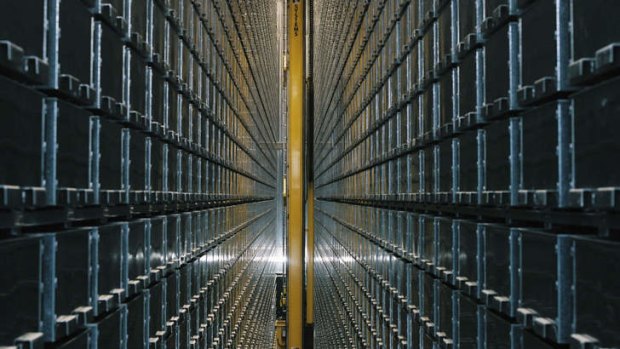This was published 10 years ago
Libraries go high-tech
Books haven't been left behind in the move to up-date libraries.
By Celia Britton
The idea of humans being served by robots is no longer confined to the realms of Science Fiction. University of Technology, Sydney (UTS) staff and students will soon start accessing books from a new library retrieval system (LRS), a state-of-the-art underground facility that uses robotic cranes to retrieve books.
The 13,000m³ facility, which is part of a much bigger building program underway at the university’s Broadway and Haymarket campuses, includes six robots and seemingly endless rows of metal shelves that will eventually hold almost 12,000 metal bins filled with books.
Increased study space, financial and energy savings and better control over the library’s collection are just some of the benefits for UTS, which has a book collection that grows, on average, by 25,000 books every year.
“It was a case of building this facility or building a library four times the size of the one we currently have, in order to accommodate the growing number of books,” says UTS University Librarian Mal Booth.

UTS's new library, like the one seen here, will have room for 1 million books.Credit: Dematic
In July, the enormous task of filling the bins with an initial load of 350,000 books (out of a total capacity of around 1 million items) will start. And although the new system is not the first to be used in an Australian library – Macquarie University opened a similar facility in 2012 – it will be the first underground system and the first in the world to use Radio Frequency Identification (RFID) technology to load and identify individual books, says Booth.
“The use of RFID tags will make the process of loading all the books so much easier and faster,” he says.
“Books will be transported from the library to the LRS and then sorted randomly by size, as opposed to subject, in order to fit into the bins. A stack of several books will then be placed on an RFID scanner and scanned at once, before being loaded into a bin. To register the books into the catalogue, a staff member will use a touchscreen to indicate which group of books is in which bin. This will be repeated until all 350,000 books are in. Our removalists, having seen what is involved, expect this to be a much faster load than we had initially planned."
At the other end, the retrieval of books is just as simple.
“Using the same catalogue as we have now, a book will be requested and the location will come up telling the user whether it is located on the shelf, has been lent out or is in the LRS,” says Booth.
“If it’s in the LRS and you want to request it, the system will let you know when the expected delivery time is and then you will come to the library to borrow it.”
Booth maintains the new library system, which is being built by Dematic and Richard Crookes Constructions, won’t change people’s borrowing habits other than making borrowing faster and simpler.
“What people need to realise is that it’s the library’s lesser-used books and collections more than 10 years old that will be placed in the LRS. Initially, 200,000 of the most popular items will be kept on the shelves, making them easier to find.
“We expect most of the books requested from the LRS will be for researchers and academics and it will add a level of convenience for them as they can order books from their desk or at home and then come and pick them up without needing to search the shelves.”
This story written and produced by the University of Technology, Sydney, for Brink, a publication distributed monthly in The Sydney Morning Herald.